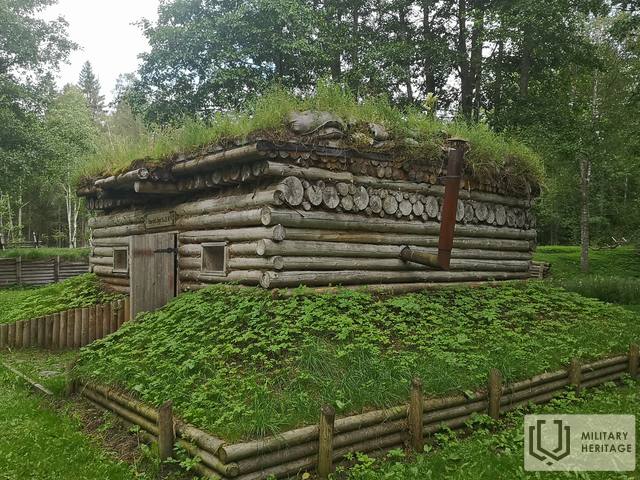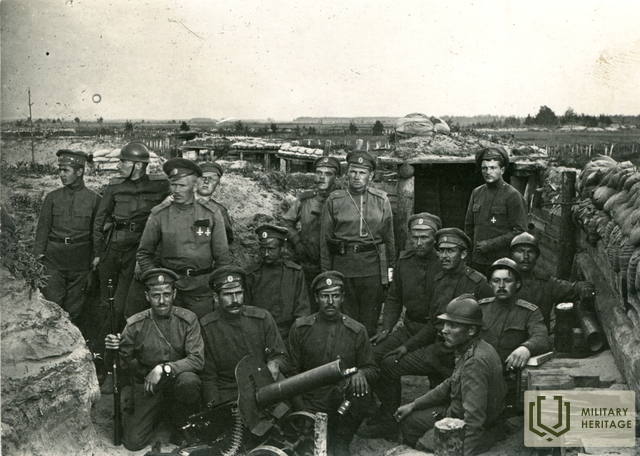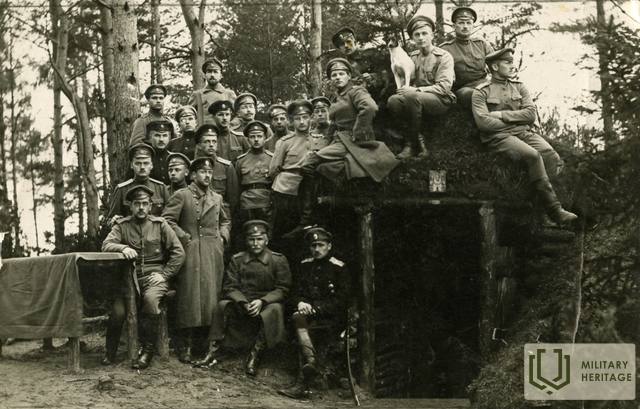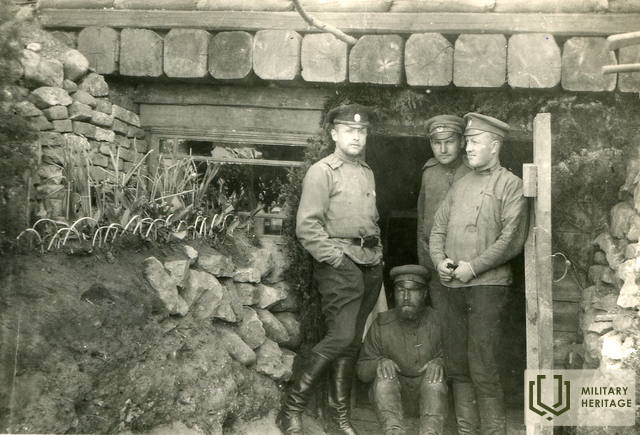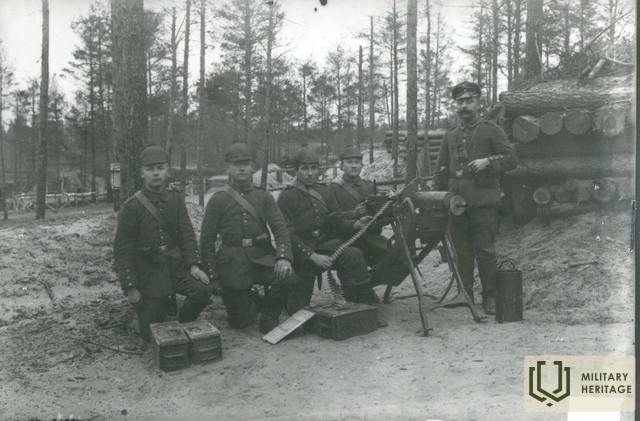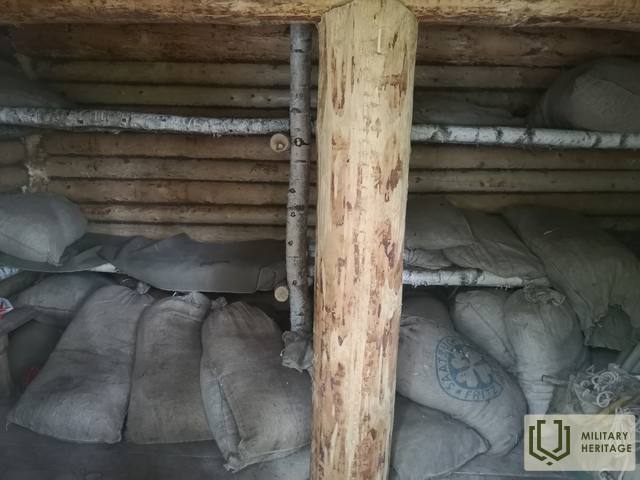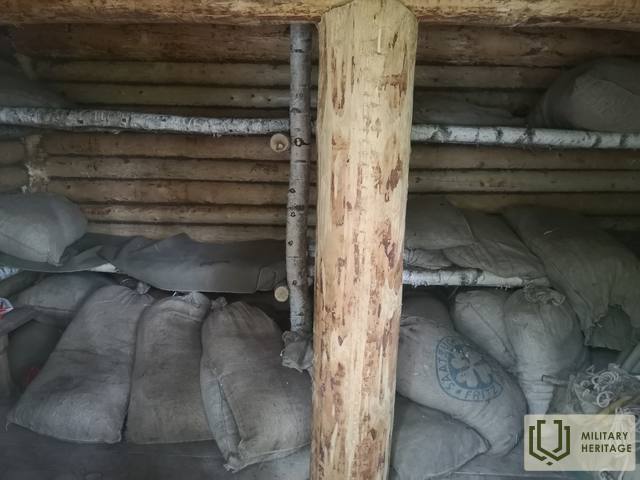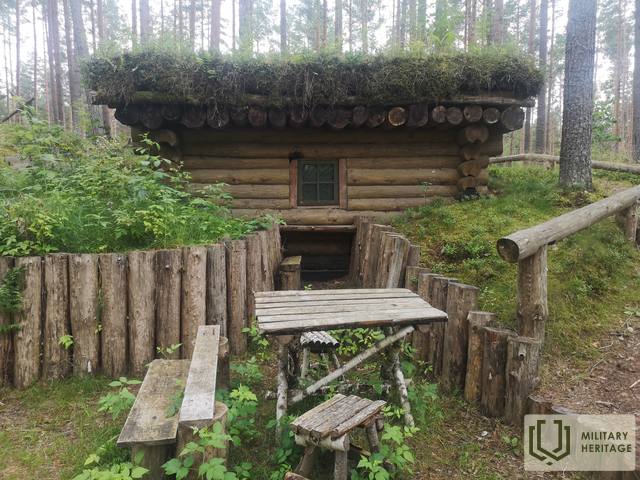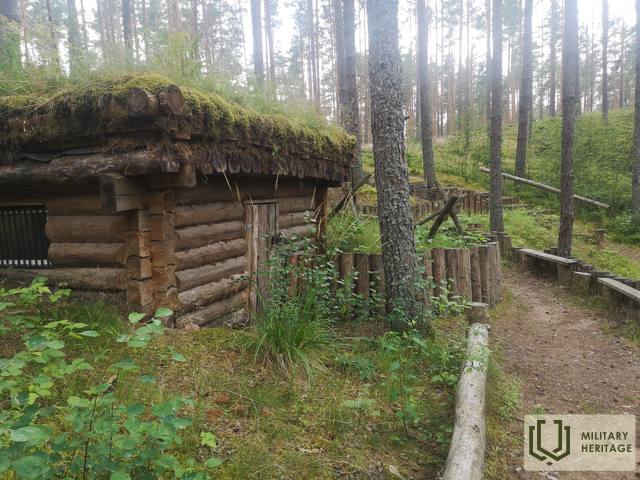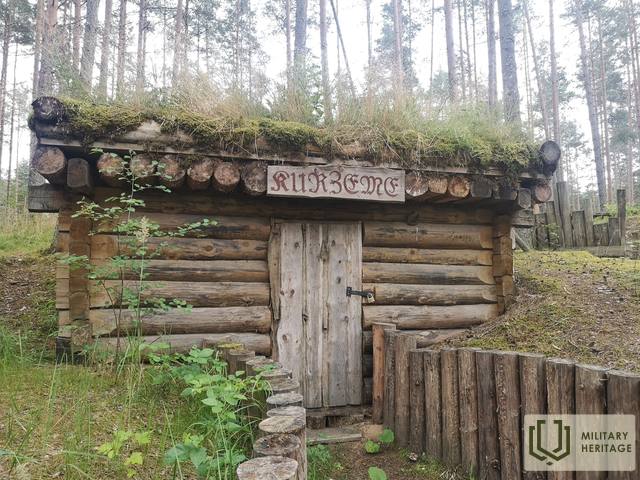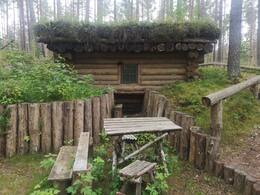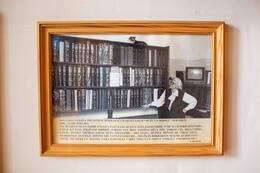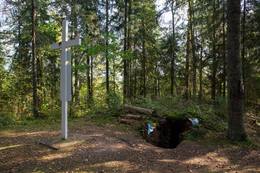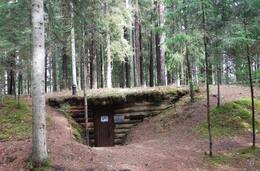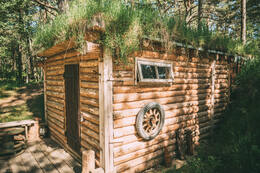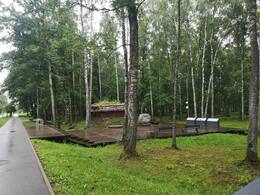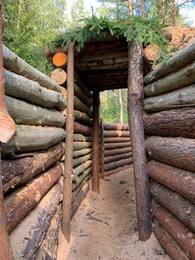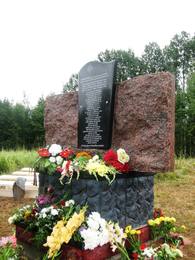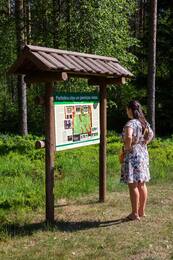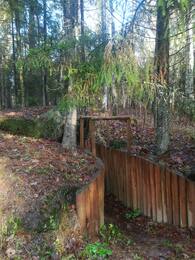Dugout
I WW1, I Wars of Independence, II WW2, III National Partizans
A circular or square dwelling with logs, cards, etc., sunk into the ground. etc. cover covered with earth. Initially, the conditions in these dugouts were very modest: a few wooden benches, a table and a stove, today the soldiers live in much better conditions, so we can only admire the warriors of that time, who lived in such a war zone for several years. The size of the dairies varied, they could accommodate from a few to 10 people. The army manuals recommended that the dugouts be 0.6 to 1.4 m wide and at least 25 cm thick, but as the war continued, the dugouts expanded, became larger, and housed an entire battalion. Larger dugouts were set up for headquarters and were usually further from the front line. The principles of the construction of the shelters were determined by the relief of the territory, the available materials and the skills of the soldiers. The size and degree of safety of the dugouts depended on the proximity of the first trench line. It is known that some shelters had more than 10 layers of logs in the roof structure, concrete slabs and iron rails were used to strengthen them, as well as viti building materials.
The dungeons were used as a place of refuge and rest by both officers and officers. The dugouts were believed to be able to save soldiers from both adverse weather conditions and artillery fire, but it was the case that an accurate broadcast killed all the inhabitants of the dugout. The factories also actively formed partisan units. We can get an idea of living and spending the night in dugouts from the memories of the shooters. Fricis Riekstiņš, a rifleman of the 1st Daugavgrīva Latvian Rifle Battalion, described the evening before the Battle of Martha or Ķekava: There was no hole for smoke in the dugout, I had to sleep and tomorrow the fierce smoke, which caused a strong cough and deep soreness in the throat. I would have loved a cold than this smoke, but whatever I do, the other members liked the heat and the smoke better than the cold.
More information sources
https://www.naa.mil.lv/en/node/222
https://tezaurs.lv/zemn%C4%ABca:1
Related timeline
Related objects
Latvian riflemen positions and trenches in Tīreļi
Latvian Riflemen dugouts and trenches in Tīreļi are located in Babīte parish, Mārupe municipality, in the vicinity of the Antiņi Latvian Riflemen Cemetery and the former medicine warehouse. During World War I this was the defensive position of Latvian Riflemen of the Russian Imperial Army. A complex of trenches and surface dugouts was built in the sandy hills. Trench or positional warfare is the best way to accurately describe World War I and emphasise the importance of fortifications. They were based on the research of military engineers and adapted to the environment and the development of new weapons. The everyday life of a soldier is a continuous improvement of defensive fortifications. Sometimes soldiers would give the dugouts names that reminded them of their homes and would help to forget about the reality of the war. Trench lines were complex defensive systems that were hard for the enemy to take. With the development of weapons these defences became even more sophisticated. The roofs of dugouts were reinforced to withstand artillery shells. Trenches were made in changing patterns and directions so that explosions would cause as little damage as possible. Movement passages had pockets that were used as short-term hiding spots during artillery fire, because they protected soldiers from shrapnel and rubble. Today part of the fortification has been restored and you can visit 3 restored dugouts and a 100 m long section of the trenches.
Museum of Melānija Vanaga and Siberian dugout
The Melānija Vanaga Museum is located in the Amata village school in Cēsis municipality. The museum showcases materials about the life, literary activity, family and destiny of writer and cultural historian Melānija Vanaga: video content about Siberia and the deported Latvians living there and a Siberian dugout taking its visitors on a trip to the writer’s place of deportation in Tyukhtetsky district, Krasnoyarsk region. The appearance and layout of the dugout form a realistic idea of life away from home. The dugout features unique historical objects brought there from the Tyukhtet Museum: a birch-bark dish known as ‘tuyesok’, a clay mug known as ‘krynka’ and a kerosene lamp. The museum features video interviews with politically repressed people from the municipality and 18 characters from Melānija Vanaga’s book Suddenly, a Criminal: Sixteen Years in Siberia. The museum’s virtual exhibition ‘BE YOURSELF!’ (http://esipats.lv) shows the experiences of five deported children and their parents who were wrongly accused by the Soviet authorities of ‘betrayal of the motherland’.
Veseta partisan dugout and memorial site "White Cross"
A 3 m high white plaque with the names of the Latvian national partisans shot on July 2, 1946 can be seen. A nearby dugout has been restored. To make it easier to find this place, there is a sign on the side of Vietalva with the inscription "White Cross".
During the Second World War, there was an active war in the vicinity of Vietalva, and the events after the end of the war were also related to it. In the post-war years, the so-called “Pārupa Group” operated here, led by Rihards Pārups (1914 - 1946).
In 1946, 10 partisans were shot dead in the area due to treason.
A memorial stone to the Pārups group has also been erected in Jēkabpils near the Krustpils Lutheran Church.
The project was implemented by former activists of the Uldis Eiduks youth guard group.
From the side of Pļaviņas, the memorial can be reached by walking on wooden footbridges and in spring and autumn the accessibility of the object can be difficult.
Video story about the exhibition dedicated to the 100th anniversary of Rihards Pārups
Rubenis' battalion bunker and battlefields
The restored dugout of the 2nd Company of the Rubenis Battalion is located in a forest by lake Ilziķi in the Usma parish. The dugout can be viewed from the outside for free at any time. However, tours inside the dugout must be booked in advance.
The Battalion of Lieutenant Robert Rubenis was part of a military unit formed by General Jānis Kurelis, and it is known for not surrendering to the German troops and showing heavy resistance. From November 14 to December 9 in 1944 fierce battles were fought in Ugāle, Usma, Renda and Zlēkas parishes between forces of the 16th German Army, SD and SS units under the command of the Police General Friedrich Jeckeln, and the battalion of the Kurelian unit commanded by Lieutenant Roberts Rubenis. The men under Rubenis’ command were well armed and organized and did not associate themselves with any of the two hostile occupying powers. Their actions are considered to be the most wide-spread and longest in the history of the Latvian national resistance movement. In battles near Renda and Zlēkas about 250 German soldiers fell, while only 50 casualties were suffered by Rubenis’ men. The events of those days are represented by the restored dugout in the forest (sod-covered, log cabin dug in the ground) where the men of the Rubenis Battalion once stayed.
Rebuilt German army dugouts in Melnsils Campsite
Campsite Melnsils is located next to the sea 10 km from Kolka. Here German Army type dugouts have been built that can be used as lodging for the night. This is a nod to the history of this region when during World War II the German Army had a border guard post and a camp site here and soldiers built dugouts for themselves using materials that could be found nearby. Trenches can still be found in the dunes along the coast.
‘Bunker Nr. 13’ is the largest of the two dugouts, with three bunk beds. The ‘Small Bunker’ is smaller and has two bunk beds. Campsite ‘Melnsils’ is a great choice for active recreation and sporting events for up to 300 people. It is located near the Slitere National Park, coastal bluffs and forest hiking trails. There are marked cycling trails that wind through the natural surroundings in the area. There are designated places for tents and campfires by the sea, as well as barrel-type guest houses for two or four people. A bathhouse with different types of whisks is also available.
WWI Historical Exploration Route and dugout
Located in Olaine, near the Olaine Museum of History and Art.
The historical route was established in 2018 at the site of the fortifications of the Russian army during World War I, which were part of the defense system of the area. The fighting between the German and Russian armies in the Olaine area attracts attention for several reasons. The marshy terrain prevented the warring parties from making rapid progress and required a variety of skills from the soldiers to operate in adverse conditions. Accurate terrain analysis, reconnaissance, and fortifications or engineering structures played an important role in the war.
Nowadays, the cognitive route is freely available and gives a rough idea of the living conditions of soldiers. The renovated buildings are closed, but can be seen by contacting the specialists of the Olaine History and Art Museum in advance.
Death Island
The group of islands is located in Daugava on the southern side of the Riga HPP reservoir near Daugmale. The Death Island is one of the scariest and most legendary battlefields of World War I. When the Russian Army withdrew from Kurzeme and Zemgale in 1915 some units remained on the left bank of Daugava, where they took positions to fight the German Army. The banks of the river were connected by a bridge. One of the largest chemical weapons usage cases in the territory of Latvia took place here. Latvian soldiers called the place ‘Death Island’, but soldiers of other nationalities called it ‘Hell’. The position of Death Island was of strategic and symbolic importance. For Latvian soldiers it was part of Kurzeme occupied by Germany. Fights took place on the banks of Daugava near Ikšķile, and in some way they were associated with the fights of the ancestors during the Crusades. Nowadays this location is accessible by boat. Territory of the Riga HPP reservoir that was not flooded can be seen. The monument designed by E. Laube still remains. Defensive position elements have been reconstructed in some places. There is an information stand on the bank of Daugava near the Ikšķile Kābeļu hill. Death Island became a group of islands after the construction of the Riga HPP reservoir was finished.
Monument to members of the resistance movement in Stompakis
It is located 15 km from Balvi in the direction of Viļakas, on the right side of the road.
A memorial is visible.
The memorial to the members of the resistance movement, dedicated to the memory of the national partisans of Pēteras Supes who fell in the battles of March 2 and 3, 1945, on the side of the Balva - Viļaka highway opposite the Stompaki swamp, was opened on August 11, 2011, on the day of remembrance of Latvian freedom fighters. At the end of July, a capsule with a message for future generations was embedded in the base of the monument. A document with the names of 28 national partisans who fell in the battles of March 2 and 3, 1945 is placed in the capsule.
"In February 1945, Latvia's largest national partisan camp was established on the islands of the Stompaku swamp, which the people began to call the islands of the Stompaku swamp, 2 km from the Balvu - Viļaka highway, where 360 people lived in 22 dugouts. Among them, some legionnaires who, for the legion division retreating, they had stayed at their father's house with all their weapons. In order to destroy the partisans, on March 2, 1945, the soldiers of two battalions of Czech troops attacked the dugouts together with destroyers, which also had four mortars in their armament. The battles took place all day, the partisans resisted stubbornly, and the attackers suffered suffered great losses, so that they could not capture the camp and destroy the partisans. 28 inhabitants of the Stompaku swamp had also fallen or died after being seriously injured in the battle. The next night, the partisans broke the siege of the camp with a battle and left undefeated" - this is what a member of the national resistance movement of the award department writes about the Stompaku battle chairman of the case commission, Zigfrīds Berķis.
Battles and memorials of national and Soviet partisans in the Griva forest massif
It is located in the Griva forest massif.
Six objects related to the places of national and Soviet partisan battles are under consideration.
In the forest massif of Griva, there are not only the headquarters of the "Purvsaliņi" national partisans, the White Cross in the bunker of the national partisans and the cross to the commander of the resistance movement Andrejas Roskoš, but also the grave of the Soviet partisan brigade commander Artūrs Balož, a monument on the so-called Maiden Hill, where a Soviet partisan died in 1944 the group of young partisans of the brigade, as well as a monument to the Soviet partisans with a five-pointed star and the engraved words "Let's cover ourselves with needles".
It is also possible to view the objects by going for a ride with a two-wheeler on bicycle route no. 785 - "Rhymes of history in the forests of Griva" (route length 34 km, gravel and forest roads). Map for download.
Memorial place for the commander of the national partisan group Andrejas Roskoš (GPS 56.87399, 27.43524)
In the autumn of 1997, the White Cross was discovered in Lielgrivas forest for the commander of the national partisan group Andrejas Roskoš.
Monument to Artūrs Balodis (GPS 56.872926, 27.478121)
Artūrs Balodis was a Soviet partisan, the commander of special tasks of sub-unit A, which was stationed in the Griva forest massif. Fell in the extensive "combing" carried out by the occupiers of Nazi Germany. The comrades carved the letters AB in the birch tree at the place where he died, so that it would not be forgotten. After the war, local researchers found the marked birch and installed a commemorative plaque in its place.
For all those who fell in the forests of Griva (GPS 56.863280, 27.47975)
This commemorative stone in the Griva forest massif has been installed by VAS "Latvijas valsts meži" in honor of the partisans who fought for their homeland. Next to the memorial stone, there is a map-scheme with indications of the partisans' headquarters and places of interest. There is also a rest area. Nearby is the settlement of the national partisans, 1945-1947.
National partisans settlement (GPS 56.863456, 27.481148)
In this place there were settlements of national partisans who fought against the Soviet occupation. The places of individual bunkers have been preserved, by their visual appearance you can judge how big and what shape the dugouts were. National partisans, resisting the Soviet power, operated in the forests of Griva for several years after the end of the Second World War.
Griva forest memorial ensemble, dugout (GPS 56.860665, 27.490439)
It was built in memory of the Soviet partisans who lived in the forests of Griva. Guerrillas blew up the local railway network and trains to disrupt the supply of ammunition, food, etc. to the Nazi German army. Memorial stones have been placed in places where trenches were dug during the war. In the restored dugout you can feel the atmosphere of wartime.
Girls' hill (GPS 56.858187, 27.521526)
In June 1944, the occupiers of Nazi Germany carried out an extensive "combing" of the Griva forests with the intention of destroying the partisans. The soldiers on the hill of Numerne besieged the economic company, which consisted mostly of young girls, and all of them were shot. Since these tragic events, Numerne hill was renamed Meitenu hill by local residents. A memorial stone has been erected at this location.
Memorial site of national partisans in Sērmūkši
Sērmūkši is home to one of more than a hundred memorials to partisan battles in Latvia. There are more than six hundred partisan battle sites in Latvia. A Latvian national partisan dugout has been built based on historical evidence, and visitors can spend the night in near-authentic conditions with plank beds, lighting provided by kerosene lamps and a heating device similar to the ones used by partisans. Visits must be booked in advance. The fateful moment for the Sērmūkši National Partisan Group came on 29 November 1946 with the deaths of four fighters from the group: Jānis Zīrāks, Reinholds Pētersons, Jānis Pīlands and Anna Zariņa. Alfrēds Suipe survived, endured deportation, returned to Latvia and saw the restoration of a free state. He initiated the idea to establish a memorial site for his fallen companions in Sērmūkši.
Bunker of the Red Army and caponiers in Aizvīkai Park
Aizvīkai Manor Park is located in Aizvīki, Gramzda Parish, just a few kilometers from the Lithuanian border.
The places of bunkers and trenches from the 2nd World War are still clearly visible in Aivvikai Park. The Red Army bunker has been restored in the park.
One of the types of weapons during World War II was the "Katyusha" rocket launch system. Several such Rocket Launching Systems were located in Aizvīki Park, even now these places (caponieri) are clearly visible in nature.
In order to get to know the cultural and historical heritage of Aizvīkai Manor Park more fully, we recommend using the services of a guide.
Evidence of the 2nd World War in Aizvikai Park
Aizvīkai Manor Park is located in Aizvīki, Gramzda Parish, just a few kilometers from the Lithuanian border.
The places of bunkers and trenches from the 2nd World War are still clearly visible in Aivvikai Park. One of the types of weapons was the Katyusha rocket launch system. Several such Rocket Launching Systems were located in Aizvīki Park, even after the end of the 2nd World War, and these places (caponieri) are clearly visible in nature.
This unique forest park, shrouded in secrets and legends, was created at the end of the 19th century as the Aizvīkai Manor Park, when the baron of the manor von Korff covered the nearby hilly land with a pine and spruce forest. Later, walking paths were laid on the 40 ha area, trees of other species were also planted and a pheasant garden was established.
In addition to the picturesque forest landscapes, there are also fairy-tale and fairy-tale figures made of wood, as well as stone sculptures, which tell travelers about events from the history of Aizvīkai and mark the cultural and historical places in the park. A Green Class has also been created in the park.
In order to get to know the cultural and historical heritage of Aizvīkai Manor Park more fully, we recommend using the services of a guide.
Related stories
About Latvian riflemen in the Olaine area
The memories reflect the daily life of Latvian riflemen in the Olaine area. Not only the living conditions are described, but also the usual task - intelligence of the opponent's positions.
Creation of defensive positions.
The description looks at the battlefield fortification in general. It is based on the experience of the First World War and the situation when it is necessary to organize extensive work on the fortifications.
Soviet Army's unrealised plans on the Kurzeme coast in Melnsil and Gipka
At the end of World War II, the 6th Battery of the German Naval 532nd Artillery Division was stationed in Melnsil, but the Red Army had its own plans for the area, which were never realised until the surrender of the German army in May 1945.




